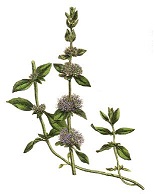THE SHAPE OF ENGLAND | Julia Evans.
Swarm.
⇒Let’s talk about pennyroyals, a flower indigenous to Europe and the British Isles that figures prominently in Julia Evans’ fantastic short story, “The Shape of England.”
This is what Wikipedia tells me about the pennyroyal: it’s a flowering plant (Mentha pulegium) with a strong spearmint-like fragrance. The herb can be used in tea and aromatherapy and has been used as a folk remedy. Its essential oil is toxic and has been used as an abortifacient.
It’s actually a pretty flower, and the fact that it smells like spearmint is nice, but the toxicity aspect of the plant gives it a very menacing significance in the story, which is intensified by the sheer pervasiveness of this plant within Evans’ narrative. In this story, pennyroyals become an invasive species. This is a very dark story.
I want to circle back to the plant significance later, but before I do let’s talk about the story’s use of the 2nd person.
There are a few different effects an author can create using the 2nd person, but in “The Shape of England” the author uses this voice to create a sense of passivity. The protagonist, the “You” character, is a young woman, just twenty. She gets married to someone whom she grows to hate–we get the sense that her reasons are quite valid, though we don’t really get any explanation of what makes the character so loathsome. Why doesn’t she get a divorce? you ask. According to the narrator, she doesn’t “know” to get a divorce. Further, we infer the protagonist lives in an era when divorce was more taboo.
When does this story take place? Hard to say exactly, but the author scatters a few temporal signposts here and there: airplanes are a thing, so we’re in the 20th century, but there is also a significant appearance by a milk boy, plus the despised husband does not watch TV but rather listens to the radio in the evenings. I’m going to go ahead and guess this story takes place about midway through the 20th century, maybe the early 50s–not typically known as a high point for women’s rights (including the right to divorce, even in the case of an oppressive relationship such as this).
Anyway, she’s only twenty, basically a kid, and we can assume a certain level of immaturity coupled with fear leads to her decision: she runs away. She leaves her a husband in the UK and flies to America, to a destination that’s high up and inland, some mountain town I suppose, and wanders north. She ends up living in a house in some unnamed location (not too many names in this piece; it’s very impressionistic that way) and ends up in a relationship with that milk boy I mentioned earlier. Various things transpire and she winds up doing something very desperate.
The You character in this story is really fascinating, a truly gray character. On the one hand, we get a sense of passivity, perhaps innocence, cultivated by the 2nd person voice. She seems like a very gentle, vulnerable person–she’s into plants and herbs and brewing tea, all of which gives us the sense that she has a very innocent spirit. On the other hand, she is also very deceptive, very manipulative: every time her then-husband had sex with her, she would consumer some of that pennyroyal stuff as a sort of old-school morning-after pill (without the husband’s knowledge). She breaks the heart of the milk boy. She does something else, too, which I won’t spoil here. There’s a Jekyll and Hyde complexity to her.
Those flowers I mentioned before, the pennyroyals, are a very fitting motif for this beautiful story. Sure, the flowers are pretty, but they’re also poisonous, and also they choke out all the other vegetation. The story may be about a pretty flower and may be about a vicious weed, but probably it’s about someone who’s a little bit of both.
